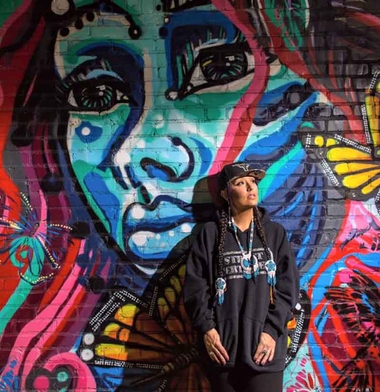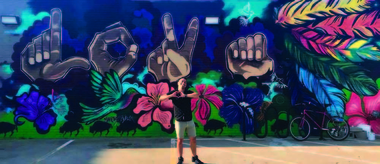Stunning mural brings “Love” to Tulsa’s Equality Center

by Rob Howard
Associate Editor
“It’s the most diverse design in the city that we’ve ever seen,” said Jose Vega, Program Director for Oklahomans for Equality (OkEq). He was talking about the stunning mural unveiled in September at the organization’s Dennis R. Neill Equality Center.
The mural, by artist Mallory Taylor, is a stunning salute to love, equality and diversity in the heart of Tulsa.
The mural had its genesis in the March 6 hate crime at the Equality Center, when a pickup pulled up in front of the building and fired 13 shots at the windows and front door. After that attack the leaders of OkEq decided to fight back with love and inclusion.
“I asked Toby [Jenkins, Executive Director of OkEq] if we could do a mural. The board of directors was all on board. ‘Let’s do an art call and see what we get,’” Vega recalled.
Taylor’s was one of the submissions and her proposal was “love at first sight”, according to Vega.
The mural is full of symbolism. “I wanted a design that was universal. I used sign language, since physical gestures are part of human communication,” Taylor told The Gayly. ‘Love’ is spelled out in American Sign Language in the mural.
“There’s quite a bit of symbolism in all my works,” Taylor related. “The hands are all different colors. I am Native American, raised in Oklahoma. The fan in the mural is in rainbow colors. The fan itself is a traditional Native American cultural reference. I also used hummingbirds, because they are very aggressive and strong.
“I like to use butterflies because Native Americans believe that butterflies are a symbol of rebirth and regeneration. Everyone in the world understands a smile and a butterfly.”

The mural took a long time from conception to completion. That was Taylor’s intent. “I specifically asked Toby and Jose if they minded that I took a little time to do the mural. The longer it takes to do the mural allows more people to get involved. If the mural had just showed up one day, it would have eliminated many conversations,” she said.
“It became more of a community effort. Just because I did the painting doesn’t mean that other people didn’t contribute to the work.”
Public reaction to the mural as it developed was amazing. “Everyone made comments, suggestions. From the first proposal it changed a bit,” said Vega.
“It has brought so much attention,” he continued. “Newlyweds have been taking pictures in front of it, the hearing impaired community feels honored. The Native American community and the LGBT community have fallen in love with it.
“It has gotten national attention. The Oklahoma travel magazine wants to make it one of their travel sites,” he concluded.
“I’m very grateful to the City of Tulsa and the neighborhoods there. They were so welcoming and kind. I hope that everybody gets to go to the center and learn what they do for the community. I’d love for people to come out and see what that facility is all about,” Taylor shared.
The mural can be viewed at the Dennis R. Neill Equality Center at 621 E. 4th Street, in downtown Tulsa.
Copyright The Gayly – November 2, 2017 @ 7:10 a.m. CDT.





